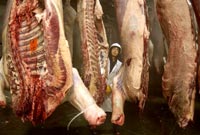2nd herd in Britain confirmed with foot-and-mouth disease
Tests confirmed a second outbreak of foot-and-mouth disease southwest of London, Britain's environment secretary said Tuesday, raising fears the highly contagious virus could spread to herds across southern England.

A second batch of cows, tested late Monday, were within the initial three-kilometer-radius (two-mile-radius) protection zone set up Friday around the farm where a first group of infected cattle was found, Environment Secretary Hilary Benn said.
The outbreak, 30 miles (50 kilometers) southwest of London, occurred just four miles (6.5 kilometers) from a laboratory that produces vaccines containing the same rarely seen strain of foot-and-mouth disease, officials said.
Benn was expecting an initial report Tuesday following checks to see whether there have been breaches in security or safety at the laboratory, which is the focus of investigations into the outbreak.
But Roger Pride, who runs the farm near Godalming, southern England, where the first outbreak was confirmed, said Tuesday he believed contamination of a local sewer could be behind the cases.
The outbreaks come on the heels of widespread flooding, and investigators are examining the possibility that the waters might have helped spread the virus.
"The theory that the sewer which overflows into part of the field where the 38 cattle were grazing could be the cause is an obvious possibility," Pride said. He said no one at the infected farm had any contact with the vaccine laboratory.
Pride said staff had realized there was a problem when they spotted the cattle were "off color and drooling."
"For a moment we couldn't believe it. We were completely shocked and devastated," he said. "It felt as if our whole world was turned upside-down."
News of a second confirmed outbreak fed fears of a repeat of scenes in 2001, when 7 million animals were culled and incinerated on pyres, devastating agriculture and rural tourism in Britain.
"We were starting to think this virus had been contained and maybe we were going to be getting back to normality in a few weeks," farmer Laurence Matthews, who owns the farm where the second infected herd grazed, told British Broadcasting Corp. radio Tuesday.
"Now this has set us back again and most farmers, and I've been speaking to a few, are very, very scared," he said. Matthews, who met Prime Minister Gordon Brown when the leader toured the region Monday, said the infected cows belonged to a fellow farmer who used his land.
Britain's Chief Veterinary Officer Debby Reynolds said Monday that the strain found in the first herd matched samples taken during Britain's 1967 outbreak of foot-and-mouth disease. The strain had not been seen in animals for a long time - but was used to produce vaccines, she said.
The vaccine laboratory is shared by the government's Institute for Animal Health, or IAH, and a private pharmaceutical company, Merial Animal Health, the British arm of Duluth, Georgia-based Merial Ltd.
Merial said it found no evidence of a breach in biosecurity, and the IAH claimed a check of records found "limited use" of the virus in the past four weeks.
Foot-and-mouth disease affects cloven-hoofed animals, including cows, sheep, pigs and goats, but does not typically affect humans.
The prime minister, who broke off a vacation to handle a response to the outbreak, said investigators were trying to pinpoint the cause of the outbreak - but acknowledged that the disease strain found in the first infected herd was the same used at the research laboratory.
National Farmers' Union president Peter Kendall said the latest case was "not entirely unexpected," given the nature of the disease.
Subscribe to Pravda.Ru Telegram channel, Facebook, RSS!

